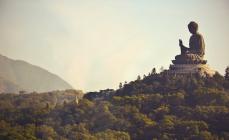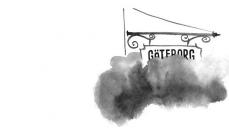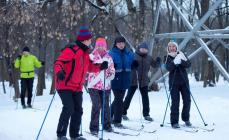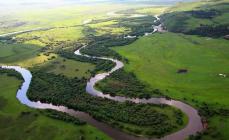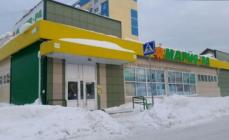Sparrow Hills- this is the name of one of the most famous parks in Moscow. It is known for the fact that various cultural events are often held here: concerts, sports competitions. Nearby are the Luzhniki sports complex and Moscow State University - the well-known Moscow State University. There is an excellent observation deck on Sparrow Hills, from which you can see beautiful view. The observation deck of Sparrow Hills is very popular with photographers. On the Internet you can find many photos taken from it.
In summer V good weather there are always a lot of people here. Mostly youth. There is a rental of roller skates and bicycles. A lot of skiers choose Vorobyovy Gory. Along the embankment of the Moskva River there is a path with a good asphalt surface. On the embankment in hot sunny weather, many swim and sunbathe. Although swimming is prohibited here and there are appropriate signs.

For example, I would not climb into this water. Various river boats ranging from boats to barges.

You can ride a boat by going a little further from the impromptu beach to the pier. Only it is worth it, in my opinion, a little expensive, something around 300 r. in 15 min. Approximate price, I don't remember exactly. Who knows, fix it. Ships of the Capital Shipping Company also stop here. can be a good continuation of a walk in the park. You can drive around, i.e. then return again to Sparrow Hills. The ticket will cost 700 rubles. You can get to the Novospassky bridge, which is on Proletarskaya. Look at and from Proletarskaya already go where you need to.
But, back to Sparrow Hills. On the embankment, we saw how the photo shoot was going on: a pretty girl with a minimum of clothes posed for a serious uncle with a large professional camera. My companion had to give an elbow to the ribs so that he would not break his neck, considering whether the shooting process, or something else.
Above, above the embankment of the Moscow River, is, in fact, the park itself. Here, in addition to asphalt paths, there are simply trodden paths. You don’t look like those in heels, all the more so these are still mountains, slopes, trees, roots sticking out of the ground, springs beat, and this is mud, slippery. For walks, it is better for girls to choose more comfortable shoes and a stronger companion so that they can support them in case of emergency. Well, or walk only on paved paths. There are pavilions, in one of which we observed how a company of 7-10 people played, only in the mafia. And why has this game become so popular lately?

The park has several ponds, which are home to a lot of different types of ducks. For comparison, ours is an order of magnitude smaller. On the banks of the ponds, many people have picnics, barbecues, etc.
in winter there is also something to do on Sparrow Hills. When enough snow falls, one of Moscow's ski slopes with a lift, etc. Fans of snowboarding and skiing can come and try this descent. I can’t say anything about prices, inventory and the quality of the descent, because. I've never been here, and I haven't skied in general.

On the square in front of Moscow State University, a freestyle ramp was built for two years in a row and international competitions were held. Demonstrations were also held here - ski jumping on snowmobiles. An exciting spectacle. Maybe in this (2011) there will be something similar.
How to get there:
Sparrow Hills are located at the metro station of the same name, red line, south of Moscow.
Years as part of the section of the Sokolnicheskaya line "Sportivnaya" - "Universitet", after the commissioning of which there were 55 stations in the Moscow Metro. To reduce the cost of construction, a unique project was used to lay the metro line along the metro bridge, instead of the previously proposed tunnel plan under the Moscow River. The station was located on the lower tier of the Luzhnetsky metro bridge (built in the year), while vehicular traffic was carried out along its upper tier. At the time of opening, the station, 282 meters long and 17.6 meters wide, was the widest and longest in the Moscow Metro. The design of the station was simple, in many respects similar to the ground stations of the Filevskaya Line opened at the same time: an asphalt floor, pillars instead of columns, simple ceiling lamps instead of chandeliers, and the main accent was the undulating ceiling of the middle nave. Construction was carried out ahead of schedule, which led to a number of design errors. To save metal and reduce noise, metal supports were replaced with reinforced concrete ones, and to prevent concrete from hardening during work in the winter months, sodium nitrate (salt) was added to the mixture, which provoked metal corrosion. When rusting, the reinforcement increased in volume, creating internal pressure in the slabs, which destroyed them and violated the waterproofing. As early as July 8, 1959, due to heavy rain, water mixed with mud was leaking into the lobby and trains. In June of the year, dural sheets of the cornice began to collapse from a 4-meter height. Over time, the bridge lost 60% of its bearing capacity, after the beginning of the destruction of concrete floors on October 20 (according to other sources, October 25), 1983, the station was closed to passengers, from the year the trains were sent over separate bridges on their own supports, built on both sides of the main one, and car traffic on the upper tier was stopped later due to the lack of an equivalent bypass highway.
Reconstruction
The active phase of work on the reconstruction of the station fell on - years - the period of construction of the Third Transport Ring, when the Berezhkovsky Bridge was erected, and thus, the possibility of a detour appeared. Thus, the restoration took 19 years. In the summer of the year, the movement of trains on the bridge was limited. From July 6 to August 5, the Sportivnaya - Yugo-Zapadnaya section was completely closed. During this time, structures of bypass bridges were brought to the main platform of the station, tracks were laid and the station was glazed.
Sparrow Hills are located on one of the seven hills of the city of Moscow.
They rise at a height of 80 meters above the Moskva River and are the most distant place from the Kremlin, where crowds of tourists tend to go. After all, it is beautiful here both in winter and summer, there is where to walk, what to see, and it’s easy to get here - you can get there by metro (the station of the same name is nearby) or by bus. In order not to get lost, advanced youth are guided by a navigator, and those who are used to using paper information carriers will be helped by a map or diagram found and downloaded on the Internet: it is easy to find on the map, for example, the address of the observation deck, from where simply fantastic panoramas of Moscow, shining in the evening, open up. colorful lights.
In contact with
History woven into the area
Why the Vorobyov Mountains? It turns out that a priest named Sparrow lived here. The village of Vorobyovo attracted Princess Sofya, the wife of Prince Vasily I, who bought the village from the priest.

A wooden palace in this place was already built by Vasily III. The building was useful to many kings, for example, Grozny himself took refuge there from the great fire of Moscow, and Tsar Alexei Mikhailovich brought his whole family and the young Tsarevich Peter to the palace for the summer.
After a while, under the leadership of Peter's daughter, wooden churches were built here, a garden, a park were placed and ennobled, alleys were laid. The reconstruction of the royal chambers belonged to Catherine the Great.
Interesting fact: Alexander I dreamed of building the Cathedral of Christ the Savior on the Sparrow Hills, but abandoned this idea due to the high cost of the project.
The observation deck remembers many conquerors who encroached on Moscow. From here, Khan Girey, Hetman Khotkevich and others looked at the capital, which opened before their eyes in all its beauty, from here they turned back, slurping unsalted.
The decline of the described area falls on the 19th century, when a prison was organized here, as mentioned by A.I. Herzen. From here, the Bolsheviks fired on the Kremlin with guns during the October Revolution. But after their victory, they became interested in this great place seriously.

The height of Moscow State University is 182 meters (with a spire - 240 m)
The complex of mansions for the highest workers of the party and the entire nomenklatura under the name "Village of Ilyich" fully met the requirements of party bosses and the ideals of communism. The cleanest air, space, beautiful view, what else is required for the well-being of senior employees. Today there is a Kremlin hospital.
In the difficult post-war period, a beautiful high-rise building was erected here as another response to the bourgeois countries. In total, 8 skyscrapers were built in the capital. The largest building in Moscow at that time was the building of the Moscow State University.
Attractions
Despite all the efforts of Kaganovich, another name did not stick to the Sparrow Hills. They were stubbornly called Leninsky, but the people, following M.A. Bulgakov, called the Vorobyov mountains.

View of the Sparrow Hills from the observation deck
The love of Muscovites and guests of the city for the area can be called great. It is good to walk here, wander around on your own or with a guided tour, admire the stunning beauty of the capital, which opens from the observation deck.
There are many attractions worth seeing here:
- The building of Moscow State University.
- Observation deck.
- Stone embankment.
- Armchair.
- Tramplin restaurant is located right on the famous ski jump, built for the Olympics-80.
- Springs.
- Pier.
- Ecological trail.
- Borodino alley.
- Monuments.
- Churches.

Here is the famous Dacha Mamontov, where Kapitsa worked in Soviet times, Landau are other outstanding figures of Soviet science.
One of the most beautiful places awaits you
Being in the capital city, you must definitely visit Sparrow Hills. Here you will find vivid impressions, interesting views, the opportunity to take wonderful photos and videos. 
Sparrow pictures of extraordinary beauty can be left as a keepsake, as well as to give to friends and acquaintances.
If you are by car, then go to Kosygin Street, leave your car in the parking lot and go up on the chair.
When walking along Zlatoglavaya, guests will not interfere with a map that will tell you directions and interesting routes.
The card will allow tourists to see all the sights of the Mother See, to make an exciting journey along the high bank of the Moscow Coast, which will remain in memory forever.
Watch the video which describes Interesting Facts associated with Sparrow Hills:
Sparrow Hills (former Lenin's mountains) is a green area on the banks of the river, a magnificent park with alleys where you can walk, rollerblade. This is an excellent observation deck in front of the Moscow State University building with the best panoramic view of Moscow in the city, a pedestrian embankment, a river station, many sports facilities, restaurants and souvenir shops.
We exit the metro station. m. Sparrow Hills.
If you come by car, then the difficulties with parking in places where it should not be difficult will surprise you - everywhere there are numerous signs prohibiting parking in the area of the observation deck of the Sparrow Hills. You will either have to break the rules, risking that your car will be taken away by a tow truck, or stop far enough from the observation deck - the center of the route. In addition, in any case, you will park the car only where you are lucky, so we will in any case be guided to start our route from the metro.
So, we leave the subway. The subway exit is one of the most original in the city. The metro platform is located right inside the bridge across the Moscow River. It is both a metro bridge and pedestrian bridge, and an automobile bridge connecting Komsomolsky Prospekt coming from the center with its continuation - Vernadsky Prospekt.
The exit from the metro is located right in the bridge body, covered with glass. Therefore, already from the subway - great view on both sides of the bridge (by the way, from passing metro trains - also). On the one hand, we see - directly Sparrow Hills, Moscow State University and Luzhniki, on the other hand - the building of the Academy of Sciences, St. Andrew's Monastery and the end of the Sparrow Hills (both the park and the embankment).
We leave the bridge to Vorobyovskaya embankment. When moving from the center, this is the direction of the first car (the beginning of the train). When looking at the Luzhniki Stadium, it's to the left.
 The embankment running along the Moskva River and the park located above the embankment on both sides of the bridge - perfect place for romantic walks, for sunbathing in summer, for rollerblading.
The embankment running along the Moskva River and the park located above the embankment on both sides of the bridge - perfect place for romantic walks, for sunbathing in summer, for rollerblading.
On a hillside in a green massif there is a monument to Herzen and Ogarev.
Below, near the embankment, there is a roller skating rink for specialized roller skating.
A high ski jump with a lift reminds you that Vorobyovy Gory is a sports facility, especially in winter. The springboard is also an identification mark. On it you can navigate to the location of the observation deck. The site is located near the top of the springboard. In fact, this is the main site, but there are other sites in the park, from where they also offer good views.


However, you will not confuse the main platform with anything. Here at any time of the year - a large number of people. With photo and film cameras, with easels. Lots of tourists, lots of weddings. Entire rows of souvenir merchants.
We rise to the site, crossing the springboard line. By the way, on the lift you can go up and down the mountain by paying at the box office for a ticket. Floating over the park, you can take pictures of the views and surroundings from the lift chair no worse than from the observation deck.


On the way from the top point of the lift to the observation deck there is a restaurant with a terrace open in summer overlooking Moscow.


Nearby you can eat in more budget option- fast food outlets are located right next to the observation deck.

On the main observation deck of the Sparrow Hills, we look at the panorama. Fabulous!
Directly in front of us is Moscow - the river and the huge bowl of the Luzhniki stadium, behind it a little to the right - the Novodevichy Convent.



On the right we see the bridge where we left the subway. Immediately behind him on the shore, even more to the right - St. Andrew's Monastery. And behind it is the tall building of the Academy of Sciences with solar panels on the roof, a little to the left of it - the Shukhov tower.

If you turn and pay attention to the objects located on the extreme left, we see the skyscrapers of Moscow City, the pseudo-Stalinist high-rise Triumph Palace on Sokol, the Tower-200 on Kutuzovsky Prospekt, and high-rise buildings in the area see Begovaya metro station.


To the right we see the Stalinist skyscraper of the Ukraine Hotel, between the nondescript factory pipes we look at the Ostankino television tower, which is very far away. We see two more skyscrapers - a building on Kudrinskaya Square, and even more to the right - the building of the Ministry of Foreign Affairs.


Between them one can consider The White house(House of the Government of the Russian Federation), the building of the Beijing Hotel, book houses on Novy Arbat and other objects.
Now let's turn our attention to central part panorama, located behind the stadium and the Novodevichy Convent.

 It is impossible not to notice the Cathedral of Christ the Savior. To the right of it, from most points of the site (but not from all!) You can see the heart of Moscow and Russia - the Moscow Kremlin. You can see white Kremlin cathedrals and dark red fortress towers. The bell tower of Ivan the Great cannot be confused with anything. Looking at a small bell tower against the backdrop of huge skyscrapers and skyscrapers located much further away, it is worth remembering that the Kremlin bell tower for a long time was the most tall building in Moscow.
It is impossible not to notice the Cathedral of Christ the Savior. To the right of it, from most points of the site (but not from all!) You can see the heart of Moscow and Russia - the Moscow Kremlin. You can see white Kremlin cathedrals and dark red fortress towers. The bell tower of Ivan the Great cannot be confused with anything. Looking at a small bell tower against the backdrop of huge skyscrapers and skyscrapers located much further away, it is worth remembering that the Kremlin bell tower for a long time was the most tall building in Moscow.
A little to the left of the Kremlin, the dark silhouette of Peter the Great with a ship's mast is a monument to the 300th anniversary of the Russian fleet.
To the left of the Kremlin - a powerful building of the Ministry of Foreign Affairs - a Stalinist skyscraper. You can search for other Stalinist skyscrapers. The third building is easy to find, to the right of the Kremlin on the banks of the Moscow River, which, of course, is not visible near the building - a high-rise building on Kotelnicheskaya embankment.


But the other two most remote skyscrapers - the Leningradskaya Hotel and the building at the Red Gate - are not very well visible and not from all points. They can be seen in the center of the panorama behind the Kremlin line.
Despite the fact that the Stalinist bulks are much larger than the ancient bell towers, they are also much inferior to modern skyscrapers. And the modern skyscraper is made in the style of Stalin, located much further (on the Sokol - the North of Moscow), it is visible much better. However, this building is still not included in the six famous skyscrapers.

The sixth building is best seen from the observation deck. However, it is not in the overview panorama, and in order to look at it, you just need to look around. And you will see the excellent knowledge of Moscow State University in all its glory. We will approach him.
Another modern building - a tower with a plate on the roof, the building of the hotel Svisotel Red Hills on Paveletskaya also attracts attention.
 A powerful bayonet - the central monument of Victory Park on Poklonnaya Hill at the far left viewpoint is not visible from every point and can be obscured by trees. Even in this perspective, where the panorama goes far to the left, it is not visible.
A powerful bayonet - the central monument of Victory Park on Poklonnaya Hill at the far left viewpoint is not visible from every point and can be obscured by trees. Even in this perspective, where the panorama goes far to the left, it is not visible.
On the panorama you can see many more interesting buildings, but this is the subject of a more detailed study.

 Let's go to the church, located next to the observation deck of the Sparrow Hills. Church of the Holy Trinity. It is believed that it was here that Kutuzov prayed before deciding to leave Moscow. And now in front of it is a gathering place for bikers and a regular free exhibition of the most expensive and diverse motorcycles.
Let's go to the church, located next to the observation deck of the Sparrow Hills. Church of the Holy Trinity. It is believed that it was here that Kutuzov prayed before deciding to leave Moscow. And now in front of it is a gathering place for bikers and a regular free exhibition of the most expensive and diverse motorcycles.
A little down the slope from the church is a memorial stone, which speaks of the merits of the Moscow City Hall.
Let's look back at the slope of the Sparrow Hills. Tsar Alexander initially wanted to build the Cathedral of Christ the Savior here after defeating Napoleon and solemnly entering Paris on a white horse. However, the hillside is dangerous because slides down into the river and large construction is undesirable here. Even the almighty Stalin had to change plans for the construction of the bulk of Moscow State University and move it away from the slope. But originally they also wanted to build it here.
After all, there is simply no more majestic hill in Moscow.
It was from here that the Master and Margarita in Bulgakov's novel started their farewell flight, on the slope of the Sparrow Hills the Master said goodbye to Moscow.
In Soviet times, they loved to make palaces out of metro stations! In the 30s they started, in the 40s they continued, in the 50s they developed and created the second metro - Leningradsky, where you could also roam! And in January 1959, the most unusual station to this day was opened in Moscow - Sparrow Hills (historically - Lenin Hills).
Instead of the classic deep tunnel, in order to save money, it was decided to create a two-level bridge structure for cars and metro trains. Saved...
1. The station is located between the Luzhniki territory and the high bank of the Moskva River in the area of Vorobyovskaya Embankment. The station is very convenient for walkers. In all directions, you can safely walk for several kilometers. But with ground transport not much here. From one side it is convenient to walk from the ultimate bus and trolleybuses "Luzhniki-Yuzhny", but on the other there is even a stop with the name of the metro station for bus A and trolleybus 7. That's just it at the very top ...
3. To see the design more clearly, we approach from the Luzhniki side. At the upper level, cars move from Komsomolsky Prospekt to Vernadsky Prospekt and back. At the bottom, a subway tunnel crawls out of the ground. 
4. The station first appeared on January 12, 1959. She celebrated her second birth on December 14, 2002. 
5. Welcome to entrance number 1. 
6. A small piece of the new navigation is already installed here. 
7. During the construction of the Luzhnetsk metro bridge, several serious mistakes were made. The lower part of the structure was a single piece, which led to a strong impact during the movement of trains. 
8. Instead of metal supports, reinforced concrete ones were installed. Salt was used to speed up concreting. Plus poor waterproofing. As a result of such reductions in prices, the station was regularly flooded. 
9. On July 8, 1969, a heavy downpour almost closed the entire line. Water with mud poured from all the cracks. Later, problems began with the ceiling. A year later, the duralumin sheets of the cornice fell. It's not even worth talking about numerous cracks. On October 20, 1983, the station closed. Since 1986, even trains have not stopped here. Parallel bridges were created for them. 
10. What we see today is actually new station. The platform has expanded to 15 meters. The trains got their own beams. And the whole object is a new name. 
11. At the same time, the station retained its idea. Through the windows you can look at the capital. BSA Luzhniki. Moscow City in the distance. 
12. The station is popular with climbers. observation deck Sparrow Hills and hurrying to tell about it by phone. 
13. For the same purpose, several round glass showcases were installed at the station, which are used for various thematic exhibitions. 
14.
15. Previously, there was an escalator gallery near the station for climbing to the very top. Closed for a long time and not the fact that it will ever be restored. 
16. There are several benches at the station. 
17. There is another problem at the station. It is often closed. For almost every major event, it is unavailable for some time. 
18. Exits. 
19. Here is such an unusual station that suffered due to numerous errors. 
And how do you feel about experiments in the field of transport? Unusual stations, unusual projects, maybe something not related to the subway?
If you know something about this place - tell us in the comments! Together we will learn more about the city!
If you have any questions, there interesting offers or want to say something - I'm easy to find on social networks.


